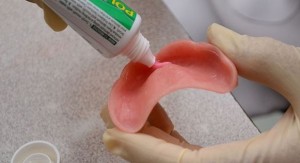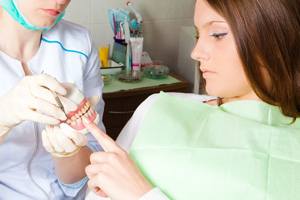Addictive to dentures

Removable dentures are both therapeutic and prophylactic.
Removable structures installed in a timely manner restore lost teeth and their functions.
They also prevent diseases of the temporomandibular joint, atrophic changes in bone tissue and deformation of the dentition.
For the first time after installation, the dental structure in the mouth is perceived as a foreign body. As you get used to it, this perception disappears.
The addiction to removable dentures with a complete absence of teeth is more difficult than with their partial absence.
- Of course, the duration of development of the structure depends on its size, the degree of fixation on the jawbone and the nature of the transfer of chewing pressure on it.
- The reaction of tissues and organs of the mouth to the prosthesis also plays an important role in the process of getting used to the design.
- It depends on the type of higher nervous activity of the patient, general health, as well as age.
Discomfort while using the prosthesis
Any inconvenience to the patient immediately after prosthetics is natural and inevitable, but all of them are surmountable and temporary.
At the initial stage of using the design, the following symptoms may be observed:
- Strengthening salivation.
- Violation of diction, chewing and swallowing.
- Decreased taste sensitivity.
- Presence of vomiting.
- Bad fixation of the structure.
Video: “Removable dentures”
How long does the adaptation take?
- On average, getting used to the clasp construction lasts no more than ten days, and to the plate-like construction - one month (with partial prosthetics).
- Patients using a complete denture, on average, learn to use it in about six months.
The effectiveness of addiction depends not only on the type of prosthesis and the quality of its manufacture, but also often on the patient himself, his mood and desire to fulfill all the recommendations of the dentist.
How to get used to
Most often, nervous, impatient patients fall into despair and do not want to use removable dentures. This is the wrong approach. It is necessary to overcome oneself and even if there is a urge to vomit, one should not remove the structure from the mouth.
- To overcome the urge to vomit, you need to breathe deeply through your nose.
- It also helps to get rid of sucking icicles.
After a few days, usually, the discomfort disappears.
If you try not to focus on the prosthesis, but distract yourself with some kind of activity, then it ceases to be perceived as a foreign body.
How to use

- The day after fixing the structure, you must go to the doctor, even if nothing bothers. Some people may simply not feel pain even if there is a mucosal injury under the prosthesis.
- If the structure causes pain, it must be removed. But before you go to the dentist 4 hours before the appointment, put on the prosthesis again so that the doctor can determine the location of the mucosal injury under the structure.
- If diction is disturbed, you need to read more aloud, first slowly and quietly, then louder and faster. So speech will recover in a week. If after two or three weeks there is no improvement in diction, then you must consult a doctor.
- In order to restore chewing, one should not use solid and dry food in the first days after prosthetics. Food is better to grind and chew slowly.
- In order to accelerate addiction to the design, do not remove it even at night, at least for a month. Remove is necessary for hygienic treatment.
- Hygienic care for prostheses must be done at least twice a day (in the morning and before bedtime). You need to brush your denture just like your teeth, using a toothbrush and toothpaste or powder.
- After each meal, the removable structure must be washed from food particles under running water and be sure to rinse your mouth. While rinsing the mouth, it is recommended to massage the gums.
- After getting used to the prosthesis, it should be removed at night and thoroughly cleaned of dirt. Then it can be immersed in a special solution for disinfection or stored in a special container.
- If the design is unstable and slides, it is recommended to use means for fixing the prosthesis. They will also help prevent the formation of gum abrasions.
You must know that the tooth structure must not be flushed under hot water. If cracks appear on the prosthesis or in case of any breakage, it is impossible to use such a design in order to avoid injury to soft tissues.
What to eat

During the period of getting used to the prosthesis, all foods can be consumed, excluding very hard and viscous foods.
Ideal - sliced vegetables and fruits.
They are quite rigid and suitable for the development of chewing skills, and are flexible, which prevents injury to the mucous membrane by the basis of the design.
Signs of addiction
- The absence of signs of mucosal irritation at the site of contact with the prosthesis.
- Patient awareness of the impossibility of existence without construction. In this case, the face of the owner of the prosthesis looks harmonious and natural.
- The patient does not have a feeling of inferiority due to prosthetics.
When correction is required

The reason for immediately contacting the dentist is the patient's complaints:
- The presence of pain at the site of contact with the structure, accompanied by damage to the oral mucosa (the presence of wounds, ulcers associated with the prosthesis).
- Soreness in the teeth and their rapid loosening.
- The presence of pain when swallowing.
- A feeling of dryness and burning in the oral cavity.